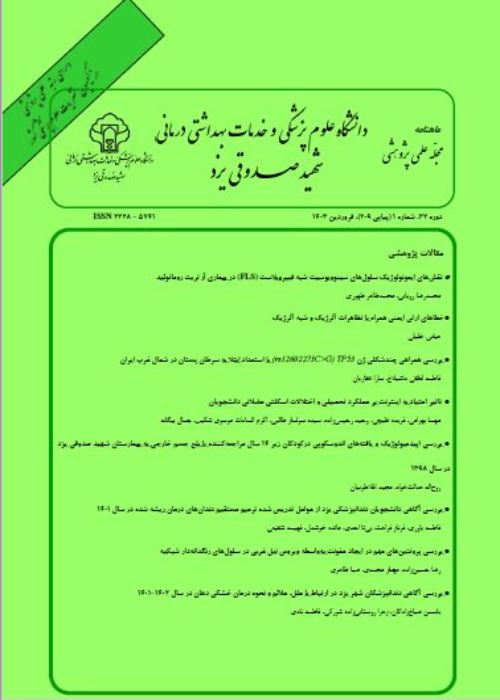Association of the ability to taste Phenylthiocarbamide with sex and smoking
Author(s):
Article Type:
Research/Original Article (دارای رتبه معتبر)
Abstract:
Introduction
The ability to taste Phenylthiocarbamide (PTC), has been long studied from genetics, epidemiologic and evolutionary point of view. This ability is associated with the ability of tasting other bitter substances which mostly are toxic. Natural selection is involved in the maintenance of the allelic frequency of PTC. Variation in the frequency of tasters and non-tasters could reflect the food preferences and dietary habits. Moreover, it can be a marker for diet-related diseases. The frequency of PTC taste sensitivity has been studied in many populations. However, no study in this regard has been reported in Iran. The aim of this research was to determine the frequency of PTC tasters and not-tasters in a population from Iran and also the association of sex and smoking with the ability to taste PTC.
Methods
In this research, 175 individuals from Shiraz University or their families were examined regarding the ability to taste PTC.
Results
The frequency of T, and t alleles was 0.58 and 0.42, respectively. There was 82.3% taster versus 17.7% non-taster in this population. There was significant difference (p=0.007, OR=4.044) between male and female regarding the ability of tasting PTC. Moreover, there was more non-taster among smokers compared to non-smokers (p= 0.002, OR=0.278).
Conclusion
To the best of the authors’ knowledge, this is the first study to investigate the frequency of PTC tasters in Iran. We have shown that, similar to studies from other populations, the frequency of PTC tasters is higher compared to non-tasters in our population. Moreover, there are more tasters among women and non-smokers compared to men and smokers, respectively. Considering that in Iran, women have an important role in providing food recepies, being more taster would help them probably to choose healtier ingredients for food recepies. In addition, investigating the connenctions between taste perception and smoking may help us to find a reliable indicator for smoking susceptibility. However, larger sample size and genetic tests are necessary to draw a more comperihensive conclusion.Keywords:
Phenylthiocarbamide , Taster , Non-taster , Sex , Smoking
Language:
Persian
Published:
Journal of Shaeed Sdoughi University of Medical Sciences Yazd, Volume:26 Issue: 7, 2018
Pages:
615 to 623
magiran.com/p1910373
دانلود و مطالعه متن این مقاله با یکی از روشهای زیر امکان پذیر است:
اشتراک شخصی
با عضویت و پرداخت آنلاین حق اشتراک یکساله به مبلغ 1,390,000ريال میتوانید 70 عنوان مطلب دانلود کنید!
اشتراک سازمانی
به کتابخانه دانشگاه یا محل کار خود پیشنهاد کنید تا اشتراک سازمانی این پایگاه را برای دسترسی نامحدود همه کاربران به متن مطالب تهیه نمایند!
توجه!
- حق عضویت دریافتی صرف حمایت از نشریات عضو و نگهداری، تکمیل و توسعه مگیران میشود.
- پرداخت حق اشتراک و دانلود مقالات اجازه بازنشر آن در سایر رسانههای چاپی و دیجیتال را به کاربر نمیدهد.
In order to view content subscription is required
Personal subscription
Subscribe magiran.com for 70 € euros via PayPal and download 70 articles during a year.
Organization subscription
Please contact us to subscribe your university or library for unlimited access!


